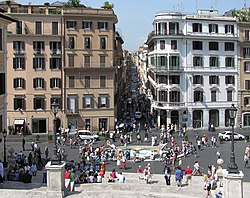

Via dei Condotti, commonly named Via Condotti, is a busy and fashionable street of Rome, Italy. [1] In Roman times it was one of the streets that crossed the ancient Via Flaminia and enabled people who transversed the Tiber to reach the Pincio hill. It begins at the foot of the Spanish Steps and is named after conduits or channels which carried water to the Baths of Agrippa. Today, it is the street which contains the greatest number of Rome-based Italian fashion retailers. It is one of the most expensive streets in Europe, [2] it is located within the Tridente, connecting Via del Corso to Piazza di Spagna.
Contents
Caffè Greco (or Antico Caffè Greco), perhaps the most famous café in Rome was established at Via dei Condotti 86 in 1760, and attracted figures such as Stendhal, Goethe, Byron, Liszt and Keats to have coffee there. [3] Guglielmo Marconi, inventor of radio, lived at Via dei Condotti 11, until his death in 1937.
Being near the Spanish steps, the street is visited by large numbers of tourists. In May 1986, fashion designer Valentino filed suit to close a McDonald's shortly after it opened near the Spanish steps, complaining of "noise and disgusting odours" below his six-story palazzo in the vicinity of Via Condotti. [4] But to the dismay of some Romans, McDonald's overcame the obstacles and is successful. [5]
Via Condotti is a center of fashion shopping in Rome. Dior, Gucci, Valentino, Hermès, Armani, Jimmy Choo, Rolex, Tudor, Patek Philippe, Prada, Salvatore Ferragamo, Celine, Van Cleef & Arpels, Dolce & Gabbana, Max Mara, Alberta Ferretti, Trussardi, Buccellati, Bulgari, Damiani, Tod's, Zegna, Cartier, Montblanc, Tiffany & Co., Louis Vuitton have stores on Via Condotti. [6] [7] Others, such as Laura Biagiotti, have their offices there. [8]
